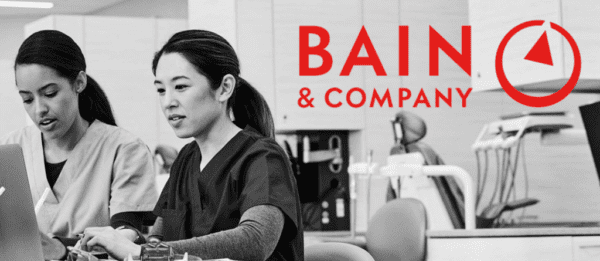|
Doubling Down on Software | Predicting IBL Malignancy
October 31, 2022
|
|
|

|
|
Together with
|

|
|
|
“Days follow days, pixels follow pixels, images follow images, schedules filled and refilled. Patients return to changed lives. Unaltered readers remain in offices, viewing more images in two dimensions, unaware of the humanity behind each study, quenching thirst from half-filled glasses.”
|
|
A poem by Barry L. Zaret MD, who is viewed as a founder of nuclear cardiac imaging and recently passed away at 82.
|
|
|
As you’ll read in today’s top story, healthcare providers are demanding solutions that make them more efficient, and that’s exactly what we discuss in the latest Imaging Wire show with Subtle Medical’s Ajit Shankaranarayanan. If you’re responsible for your organization’s imaging efficiency or think your team might benefit from faster scans, you should watch this video.
|
|

|
|
A new Bain & Company and KLAS Research report suggests that healthcare providers are “doubling down” on software, while revealing key adoption trends that could have a major impact within radiology.
Software Growth – Despite macroeconomic turbulence, the many provider organizations are actively increasing their software investments.
- During the last year, 45% of providers accelerated their software investments, while just 10% showed software spending.
- Looking towards 2023, over 95% of providers expect to make new software investments and one-third plan to invest more than usual.
- Software is now a top five strategic priority for nearly 80% of provider organizations and a top three priority for almost 40%.
Problems & Solutions – The major challenges facing healthcare providers also happen to be the primary software adoption drivers.
- Nearly 80% of providers who accelerated software investments last year cited labor shortages, wage inflation, or restructuring (M&A, change in leadership) as their top adoption catalysts.
- Going forward, providers are prioritizing solutions that improve staff productivity and efficiency, capture more patient revenue, and improve security.
From a radiology perspective, that likely means a (continued) focus on solutions that enhance staff productivity and efficiency, improve patient intake/flow, and drive hospital revenue.
Streamlining Tech Stacks – Accelerated software adoption and the proliferation of new software vendors has left providers overwhelmed by their tech stacks.
- Over 50% of providers are struggling with the flood of offerings, and 24% believe that their existing tech stack keeps them too busy to stay current on new solutions.
- Providers also cite poor cross-solution interoperability as their top tech stack pain point.
- As a result, 72% of providers will first attempt to add software from existing vendors before considering new companies, and 63% are looking to reduce the number of third-party solutions in their tech stacks.
In radiology, this trend likely favors the leading informatics players, while fortifying the value propositions of AI platform/marketplace vendors, unified imaging IT vendors, and extremely well-integrated point solutions.
The Takeaway
Even if Bain is targeting a broad healthcare audience, it’s clear that the macro trends highlighted in this report are having a similar impact within radiology, giving imaging teams and their vendors a solid framework to guide the next phases of their software adoption.
|




|
|
Boosting Productivity and Reducing Burnout with Workflow Optimization
It’s no secret that radiologists are increasingly burned out, but there are technology-based solutions to this problem. Check out this GE Healthcare report detailing how a workload optimization engine can boost radiologists’ productivity and reduce burnout.
|
|
- Predicting PET/CT Bone Lesion Malignancy: New NCI research highlighted 18F-DCFPyL PET/CT’s ability to predict malignancy in indeterminate bone lesions (IBL), potentially reducing the need for biopsies. Analysis of 243 patients with high-risk primary or biochemically recurrent prostate cancer (w/ 98 IBLs) who underwent 18F-DCFPyL PET/CT imaging, showed that 88.1% of malignant IBLs had SUVmax ≥5 or were present with bone metastases, while 91.9% of benign IBLs had SUVmax <5 and were present without bone metastases.
- Positrigo Brain PET Funding: Swiss PET startup Positrigo secured $5.57M in Series B funding (total funding now $13M) to complete its ultra-compact NeuroLF brain PET system’s regulatory approvals and develop its commercial operations. Positrigo seeks to expand access to PET-based neurological disease screening and diagnosis, leveraging the NeuroLF’s much smaller size and lower capital investment than traditional PET scanners.
- VR TAVR Planning: A Spain-based study highlighted virtual reality imaging’s potential to help cardiac surgeons plan TAVR procedures, providing a more immersive way to evaluate pre-procedure multidetector CT exams. The authors used their self-developed VR system with 11 TAVR patients, finding that VR provided adequate image quality for segmentation, led to implant strategy changes in 5 cases (45%), improved the team’s confidence for all cases, and led to good outcomes with no complications.
- Multi Reminders Reduce No-Shows: A University of Maryland-led study showed that sending a combination of phone, email, and text-based appointment reminders significantly improves mammography screening attendance and scheduling efficiency. Analysis of a UMMC breast imaging clinic’s attendance in 2017 (before implementing multi-reminders) and in 2019 (after implementing reminders) revealed a 35% decline in screening no-shows (368 to 238) and a 60% shorter wait time to reschedule a missed appointment (30.7 to 12.1 weeks).
- ScanNav Anatomy PNB’s Clearance: Intelligent Ultrasound announced the FDA clearance of its ScanNav Anatomy PNB system (already cleared in UK & EU), an ultrasound AI solution for peripheral nerve block injection guidance. Intelligent Ultrasound offers its other ScanNav solutions through a partnership with GE Healthcare, and it’s possible that ScanNav Anatomy PNB will follow a similar partner-connected path to market.
- Bridging the TTE Critical Care Gap: New research out of the UK showed that DiA Imaging Analysis’ LViVO cardiac ultrasound AI software can help critical care departments bridge the transthoracic echocardiography (TTE) skill and subjectivity gap. The authors used LViVO to analyze TTE exams from 50 critically ill patients that were performed by a TTE specialist, finding that the software could run full LV analysis with 52% of the images and RV analysis with 64% of the images.
- VBC Pocket Guide: Rock Health published “a pocket guide” to value-based care to help providers, payors, and life sciences orgs untangle the competing narratives around risk-based contracts. It’s short and sweet, and doesn’t get into radiology, but it’s a solid blueprint for anyone looking to brush up on the space or figure out the first steps to their VBC approach.
- Siemens CXR AI’s Multi-Site Performance: A new study highlighted Siemens Healthineers’ AI-Rad Companion Chest X-ray solution’s performance in a multi-site hospital environment. The solution automatically triaged 1.4k CXRs from 10 clinical sites for five findings before routing them to radiologist worklists (pneumothorax, pleural effusion, pulmonary lesions, consolidation, atelectasis). The solution didn’t slow the radiologists’ diagnostic workflow, and matched the rads’ opinions in 80% of cases, while providing the greatest value with difficult findings (e.g. a lesion behind the heart).
- SDOH’s Follow-Up Imaging Impact: A Brigham and Women’s Hospital study further confirmed that socioeconomically disadvantaged patients are less likely to complete recommended follow-up imaging, encouraging more efforts to reduce follow-up disparities. Analysis of 4,881 recommendations for 4,599 patients (74.8% of follow-ups completed) showed that patients who live in socioeconomically disadvantaged neighborhoods are less likely to complete follow-up imaging (odds ratio:0.67).
- Clarius Launches Marketplace: Handheld ultrasound vendor Clarius Mobile Health announced its new Clarius Marketplace, and its initial list of AI solutions partners available through the platform (ThinkSono, DESKi, Pocuspro). The launch came with an update to Clarius’ SDK that streamlines the process to integrate third-party AI software with its app, ultrasound systems, and cloud exam management platform.
|
|
- Enterprise imaging is mainly adopted in the largest hospitals, but that doesn’t have to be the case. Check out this Imaging Wire Show featuring Novarad product leader Dave GrandPre, where we discuss what’s caused this divide and why smaller hospitals should adopt enterprise imaging.
- Check out this patient case study showing how the Arterys Chest I MSK AI allowed radiologists at CSE in Paris to identify a fracture that was missed in three previous interpretations.
- Enlitic’s Curie|ENDEX software conforms messy metadata to a standard convention, making radiology data searchable and hanging protocols more reliable. And as Enlitic’s new ROI calculator shows, those imaging efficiencies create notable time and cost savings.
- MRI machines require 7,000 tons of helium every year, with per-machine helium costs of up to $39k annually, but it doesn’t have to be that way. See how the low-field Hyperfine Swoop avoids helium and infrastructure costs, while bringing MR neuroimaging into completely new clinical settings.
- Find out what built for the modern world means — and why it matters — in this Aunt Minnie profile on United Imaging’s more modern approach to vertical integration, leadership, and culture.
- The USPSTF guidelines for lung cancer screening were updated in May 2021, and driving compliance to such guidelines is a long, slow, repetitive process. Because of that, the Riverain team put together a kit to help hospitals and imaging centers educate either referring physicians or patients on the new guidelines either via branded tools or through the media.
- Annalise.ai doubled-down on its comprehensive AI strategy with the launch of its Annalise Enterprise CTB solution, which identifies a whopping 130 different non-contrast brain CT findings. Annalise Enterprise CTB analyzes brain CTs as they are acquired, prioritizes urgent cases, and provides radiologists with details on each finding (types, locations, likelihood).
|
|
|
Share The Imaging Wire
|
|
Spread the news & help us grow ⚡
|
|
Refer colleagues with your unique link and earn rewards.
|

|
|
|
|
Or copy and share your custom referral link: *|SHAREURL|*
|
|
You currently have *|REFERRALS|* referrals.
|
|
|
|
|